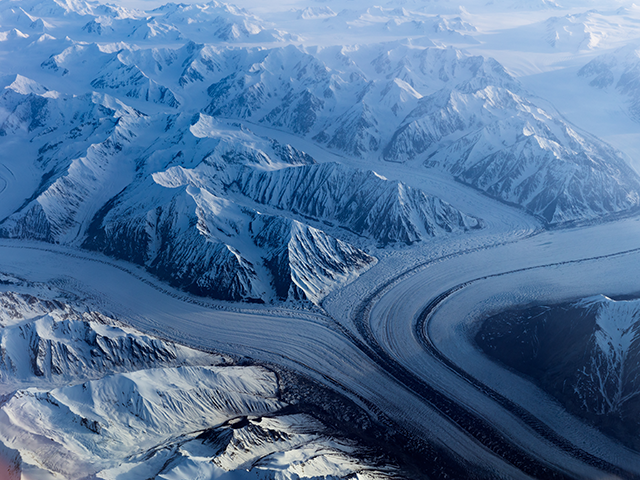The Royal Canadian Mounted Police (RCMP) announced on Friday that the search for debris from a “suspected balloon” shot down by the North American Aerospace Defense Command (NORAD) over the Yukon a week earlier has been suspended.
“Given the snowfall that has occurred, the decreasing probability the object will be found and the current belief the object is not tied to a scenario that justifies extraordinary search efforts, the RCMP is terminating the search,” said the RCMP press release.
Documentary filmmaker Andrew Gregg, who made a movie in 2022 about the complete disappearance of a sizable American military plane with 44 passengers in the same region in 1950, told Canada’s CBC News he was not surprised the search for the Yukon balloon came up empty-handed.
“Not a rivet has turned up,” Gregg said of the missing plane from 1950. “So yeah, the Yukon has an ability to just absorb these things.”
“How do you find something when you’re not even sure what it is, in a place like the Yukon wilderness, in the winter? Like, I have no idea how you even begin,” Gregg said.
Yukon Civil Air Search and Rescue Association chief David Downing was a bit more optimistic when he talked to the UK Guardian last week, citing advances in technology and lessons learned from the massive but unsuccessful search for the Skymaster plane chronicled in Gregg’s documentary. However, Downing noted the simple fact that balloon debris could be covered by snow within minutes of coming down in the winter, which could thwart even the most sophisticated and determined search effort.
“Even if they fly right over something, even if it’s right in front of them, the chances of missing it are really high,” Downing said.
The Yukon object was one of three unidentified targets destroyed by U.S. jets on the weekend of February 11, shortly after a Chinese spy balloon completed its long journey across the continental United States and was shot down over the Atlantic Ocean.
Searches by the U.S. military for debris from the other two objects, destroyed over Alaska and Lake Huron, have also been called off.
Canadian Prime Minister Justin Trudeau said on February 11 that he requested the shootdown of the UFO over Yukon, and ordered Canadian forces to recover the wreckage after a U.S. F-22 fighter took the shot.
CTV News noted on Saturday that Canadian military officials were keen to analyze the debris from the Yukon object, and will doubtless be disappointed by the end of the search:
Lt.-Gen. Alain Pelletier, deputy commander of the joint U.S.-Canadian air surveillance and defence command known as Norad, had said officials hoped to retrieve the objects to analyze them and get a better understanding of their capacity and origin.
Federal Defence Minister Anita Anand said last week it was too early to tell whether the “cylindrical object” shot down over central Yukon was from China, but said it was “potentially similar” to the Chinese spy balloon destroyed off the coast of South Carolina on Feb. 4.
The Yukon object has been the subject of much speculation, and a good deal of derision, because there is some evidence to believe it was an amateur radio balloon launched months ago by a group called the Northern Illinois Bottlecap Balloon Brigade (NIBBB).
According to NIBBB member Cary Willis, the club’s “pico balloon” was a 32-inch silver mylar sphere carrying a tiny radio tracker, a solar panel, and about 33 feet of antenna wire. Pico balloons have become popular with amateur radio enthusiasts because they are inexpensive but capable of ascending to prodigious heights and staying afloat for long periods of time. The electronics package attached to a typical pico balloon weighs less than one ounce, but it can transmit a very low-power, low-bandwidth signal across thousands of miles.
The NIBBB balloon, designated K9YO-15, was launched 123 days before the club lost contact with it on the weekend of February 11, and had already circled the world six times — an impressive feat for a pico balloon, especially if it took a couple of $450,000 missiles fired by a top-shelf $216 million jet fighter, with authorization by the President of the United States and the Prime Minister of Canada, to stop it from completing a seventh journey.
Responses from pico balloon enthusiasts to the Yukon incident have ranged from mockery of the U.S. and Canadian governments for panicking and using such powerful weapons to destroy a $13 mylar balloon, to admiration for the fighter pilot who managed to hit such a tiny object, to glee that pico ballooning is suddenly a much more famous hobby, and finally to apprehension that governments might decide to crack down on the balloons as threats to national security and civil aviation. Unfortunately, the suspension of the RCMP’s search effort means the final fate of K9YO-15 may never be known.

COMMENTS
Please let us know if you're having issues with commenting.